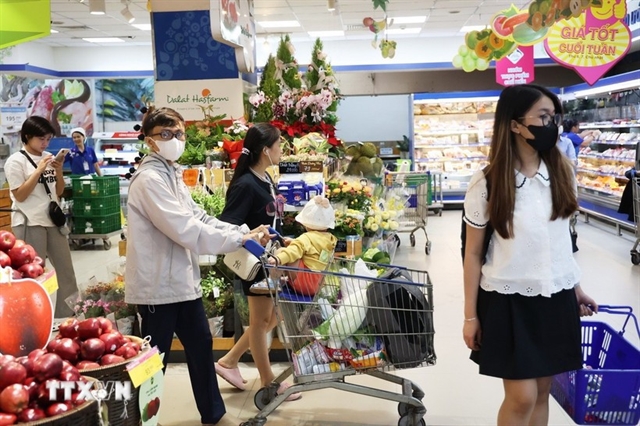 Society
Society

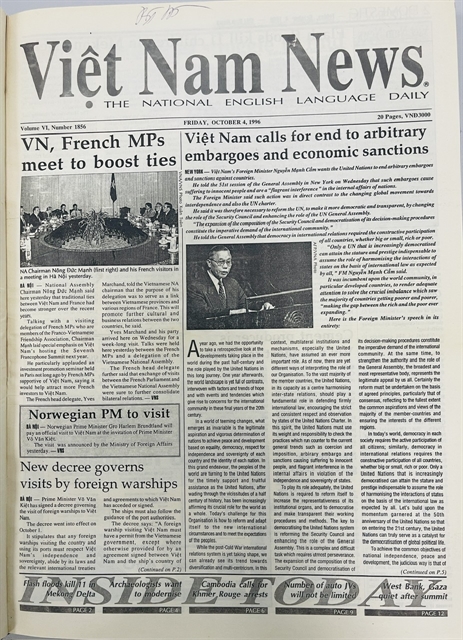 |
| The front page of Việt Nam News on October 4, 1996. VNS File Photo |
Khánh Dương
Deputy Prime Minister and Minister of Foreign Affairs Bùi Thanh Sơn has emphasised that "foreign service information" plays a vital role in telling beautiful and proud stories about Việt Nam, enabling the international community to better understand, support and stand with the country.
Today, around 250 press agencies in Việt Nam publishing in foreign languages are taking on this vital role. As an integral part of Việt Nam's revolutionary press, foreign service journalism has consistently worked to fulfil its noble mission – providing accurate, objective and positive information for foreign readers and viewers.
Over the past 100 years of the revolutionary press, external information services have made significant contributions to national communication efforts. In the past four decades especially, these services have been at the forefront of connecting Việt Nam with the world – enhancing its global presence, reputation and influence.
The term "foreign service information" was formally recognised in 2013, which approved the Government's Action Programme on Foreign Service Information for the 2013-20 period.
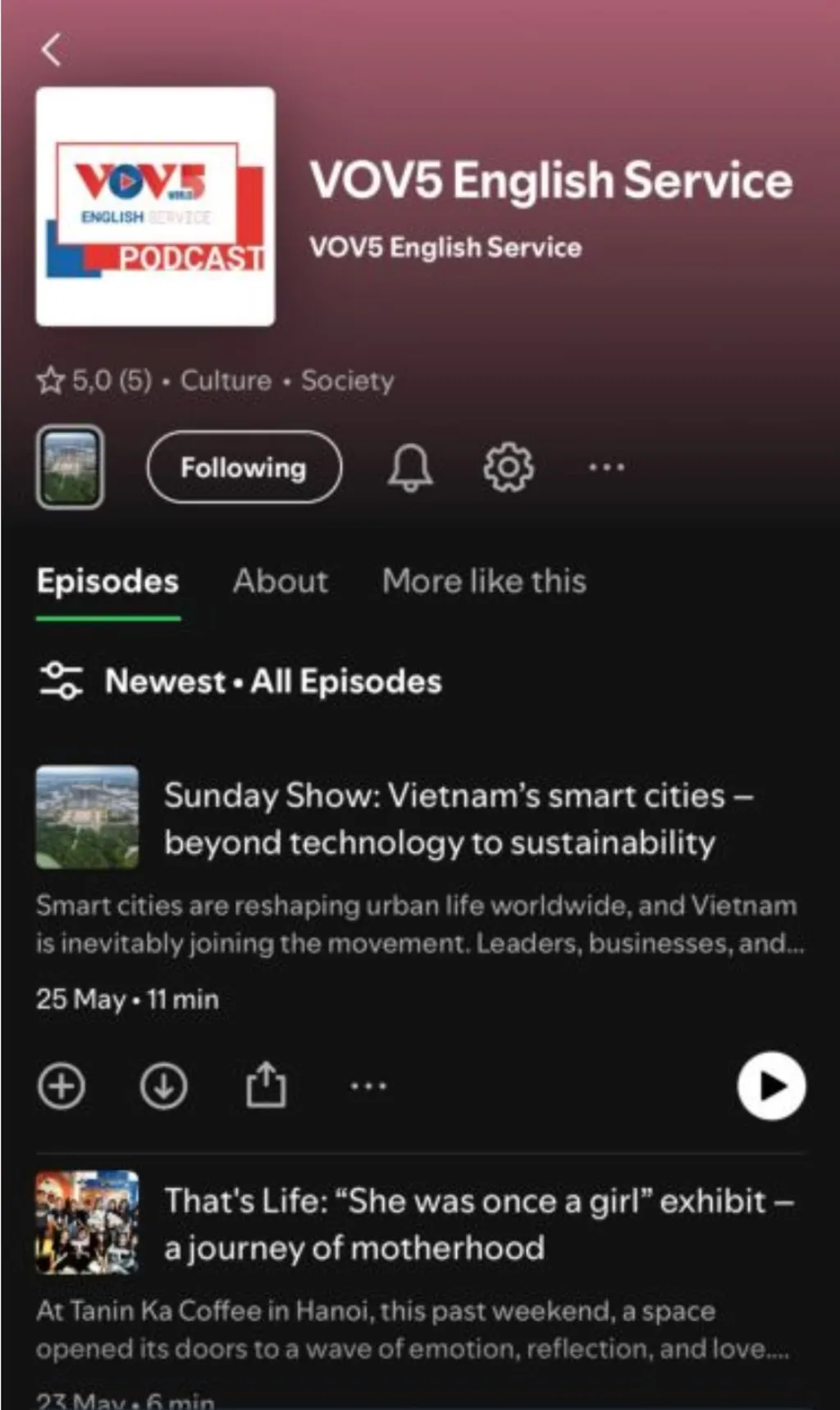 |
| VOV5 on Spotify. |
However, journalism fulfilling external service roles began much earlier, with the introduction of foreign-language magazines such as Vietnam Pictorial in 1954 and Le Courrier du Vietnam in 1964.
From the late 20th century, external service journalism entered a dynamic phase with the establishment of several key media outlets, including The Journal of International Relations (now The World and Vietnam Report), first published in November 1989; Việt Nam News, the country’s first daily English-language newspaper, launched in June 1991; Vietnam Investment Review (the English version of the Đầu Tư newspaper), first issued in September 1991, and VietnamPlus, the national online world service newspaper published by the Vietnam News Agency (VNA) from September 2008.
Việt Nam's world service media system includes print, online, radio and television sources. Each has different advantages for overseas service, including multilingual publications that serve a wide international readership.
Phó Cẩm Hoa, director of the Radio the Voice of Việt Nam’s world service department (VOV5), said it had so far been the provider with the most powerful and wide-ranging presence in external communication across all media platforms.
“We have developed initially from broadcasting in three foreign languages 80 years ago, to currently 13 languages," Hoa said.
"The selection of languages is based on criteria such as global prevalence, strategic importance, and geopolitical context. We also have an overseas programme specifically designed for more than 6-million Vietnamese diaspora around the world," she said.
Vietnam Television's external channel, VTV4, began as a programming for overseas Vietnamese in 1998 and has since become the country's major international service channel. It provides official and thorough information about all elements of Vietnamese politics, economics, culture and society, as well as the overseas Vietnamese.
VTV4 broadcasts to millions of viewers in over 200 countries and territories worldwide in a variety of languages, including Vietnamese, English, French, Russian, Chinese, and Japanese.
Meanwhile, the VNA has three divisions that handle the foreign service information missions allocated by the Government.
The English language daily Việt Nam News, the multi-language magazine Vietnam Pictorial and the multi-language electronic newspaper VietnamPlus have been designated as the national print and digital foreign-service newspapers towards 2030.
VietnamPlus, the largest multilingual online newspaper in Việt Nam, now offers services in five foreign languages.
According to Trần Tiến Duẩn, editor-in-chief of VietnamPlus, its advantages maintain a guiding and orienting role in mainstream information flows and major national and international events.
“This is why VietnamPlus is considered a reliable source of news for other media outlets to cite, with over 130 newspapers, magazines and online platforms sending official requests to republish our articles,” he said.
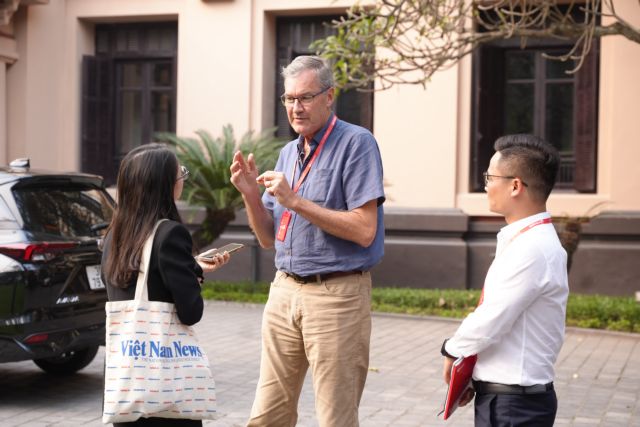 |
| Việt Nam News reporter Nguyễn Thu Hằng interviewed Darrell Wade, co-founder and chair of Intrepid Travel in 2024 in Hà Nội. VNS Photo |
Meanwhile, Nguyễn Minh, Việt Nam News editor-in-chief, said "the publication does not merely introduce Việt Nam, but also actively engages in shaping public opinion, countering misinformation and safeguarding national interests".
“We are not just reporting news – we are also competing in terms of quality, accuracy, speed and, most importantly, maintaining a trusted voice amid a sea of cross-border information,” he said.
Elsewhere, with a 64-page print edition in English, Chinese, Spanish and Lao distributed to more than 130 countries and territories, and with a monthly circulation of 24,000 copies, Vietnam Pictorial has been assigned as a national foreign service magazine with regional and global influence.
The online version of Vietnam Pictorial is published in 10 languages and receives approximately 20 million regular visits from readers in over 140 countries and territories worldwide.
Keeping up with tastes
Foreign service information providers in Việt Nam must adjust to meet the changing demands of readers and audiences in the digital age.
With the rise of social media platforms and mobile journalism, the job of journalists in the external service industry is no longer restricted to researching themes, conducting interviews, and publishing articles. They must devise new methods of communication in order to attract more readers and audiences.
Việt Nam's foreign service news organisations use AI, big data and multimedia to increase quality and reach target audiences.
At VOV5, for example, the world service content has been distributed through new platforms like apps VOV Live and VOV Media, streaming services, radio on demand and podcasts. Podcast episodes are published on both websites and mobile applications, and promoted across multiple platforms including Spotify, YouTube, TikTok, and Facebook.
Director Hoa of VOV5 said the explosion of the internet, online journalism, social media and AI had fundamentally changed the way people access information. Today, people could easily access information about Việt Nam from a variety of sources, and could automatically translate it into multiple languages.
“If we fail to keep pace with the times – without applying AI, or remaining stagnant with traditional broadcasting as it was 20 years ago – we will inevitably fall further behind and lose more and more audiences,” she said.
“Twenty years ago, our main concern was just content – how to make programmes more interesting and well-formatted. But today, even good-quality content is not enough," Hoa said.
"Audiences have changed their habits and no longer engage with a traditional radio broadcast. The real challenge lies in delivering that content through platforms and formats aligned with their taste.”
Nguyễn Thị Phương Liên, VTV4 deputy director, believes technological integration is the key for Việt Nam’s foreign service information agencies to expand their global reach and contribute to building a more prestigious and high-profile image of the country on the international stage.
"VTV4 has leveraged multimedia platforms, high-quality videos, interactive content and big data analytics systems to accurately, promptly and vividly convey information about Việt Nam and its people," she said.
VietnamPlus places strong emphasis on enhancing content quality by integrating multiple media formats into a single product, such as photo series, video clips and infographics.
Editor-in-Chief Duẩn said the editorial board set a requirement for all reporters to produce multimedia content. Every assignment must include not only written articles but also photos and videos.
"High-quality pieces are meticulously produced in long-form format, combining various multimedia elements and reflecting leading trends in global journalism today, such as visual journalism and data journalism," he said.
"These works meet the high-quality standards outlined in the national project for the development of select print and digital foreign-service newspapers by the VNA."
Việt Nam News is now no longer merely a print newspaper, but now also operates an online edition along with various specialised digital sections. This is accompanied by the production of numerous multimedia products and a strong presence across multiple social media platforms, enabling it to reach a broader international audience.
AI has been applied by journalists providing foreign service as an effective tool helping them to transform from voice to text, translation and voice over.
Việt Nam News Editor-in-Chief Minh said some AI tools had been used in the editing process to detect spelling and grammar errors, refine English expressions and design illustrations for certain newspaper front pages.
"Foreign-language newspapers need to actively use AI applications in translation, editing and proofreading to help save human resources and increase the efficiency of information delivery," he said.
“In the era of social media and widespread AI-generated content, journalists need the ability to verify information, distinguish between right and wrong, possess critical thinking and demonstrate caution and integrity in every word, image and headline.”
VTV4 deputy director Liên said the emotional element – the invisible thread connecting content with the audience – remains something that AI has yet to grasp and convey as subtly as humans can.
"The emotional resonance of a human-centred story, the empathy towards individual lives, or the ability to immerse oneself in a social context and retell it with rich, heartfelt language are qualities that stem from the experience and soul of a journalist," Liên said.
"A harmonious integration of modern technology with the traditional identity of journalism not only helps journalists maintain their relevance but also enhances the quality and impact of media products," she added.
However, VOV5 director Hoa said AI is a double-edged sword.
“If we become overly reliant on AI for translation and depend too much on human editors to polish the work, we will never truly improve. When the older generation retires, the young generation now will become the editors, then there will be no one left to do the editing for the next generation,” she said.
Pressure and competitiveness
Saying that foreign service journalism now has to face lots of pressure and competition from international media and technology conquest, these industry leaders agreed that besides content innovation, technology upgrade was what foreign service journalism in Việt Nam would need.
Hoa said: “We expect the State to invest more in technology because it is very costly. If we want to keep up with the rest of the world, then, no matter how good our content is, without up-to-date technology, we simply cannot catch up.”
Nguyễn Thắng, editor-in-chief of Vietnam Pictorial, said investment demands on technology were even greater and more costly.
"This year’s cutting-edge camera model may be quickly replaced by a superior one the following year. Photo editing software evolves at a dizzying pace and must be regularly updated to meet professional requirements," he said.
 |
| 'Vietnam Pictorial' is displayed at an exhibition in Hong Kong, China. Photo courtesy of Vietnam Pictorial |
He added that unlike other types of media, foreign service media faced significant challenges in generating revenue or attracting advertisements, as its core functions and duties would not lend themselves easily to commercial profit-making.
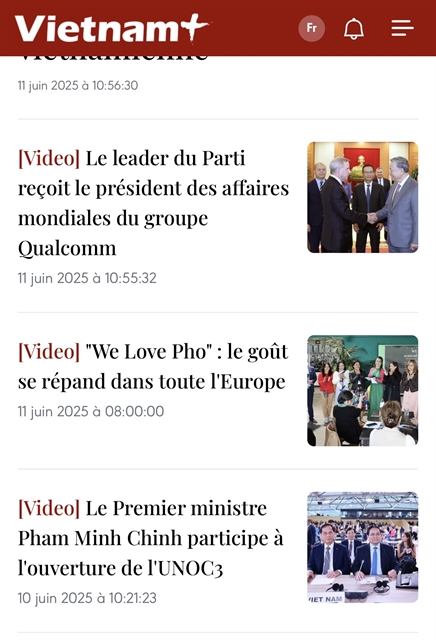 |
| Videos in French on vietnamplus.vn |
Duẩn said that VietnamPlus and other external information providers faced challenges related to policies, especially the commissioning mechanism for foreign-language journalism, particularly when it comes to launching innovative, high-quality, in-depth and engaging journalistic products.
"Other difficulties come from establishing connections with individuals, partners, corporations and foreign enterprises to encourage their engagement with Việt Nam. External information providers need a national comprehensive strategic plan to develop the foreign service information," he said.
Looking to the next decade, managers of foreign service information agencies have sketched out a landscape where the sector will continue to be the main force in disseminating the Party and State’s policies and guidelines to the world, introducing Việt Nam’s image in all fields to foreign audiences.
Editor-in-Chief Minh said Việt Nam could not stand outside the global communication trends.
“In the next 5 to 10 years, we must continue to proactively integrate in terms of technology, international journalistic language, and actively participate in regional information forums and collaborate with major media organisations," Minh said.
"Integration enhances our ability to amplify Việt Nam’s voice on global issues and contributes to how the world understands Việt Nam – not only through policy communication, but also through our culture, people and the nation's aspirations for development.”
Each agency, with its own strength, has mapped out plans to uphold foreign service information’s position in the face of the digital era and international integration.
Duẩn said VietnamPlus would increase the production of in-depth, highly informative articles to attract demanding foreign readers and overseas Vietnamese, with emotionally powerful videos and reports showcasing reactions to Việt Nam’s wonders, scenic spots, historical sites and major projects.
Talking about plans to expand the advantages of VTV’s world service, Liên said Vietnam Television would establish and develop a new channel, tentatively named Vietnam Today. This national channel would provide external broadcasting services in English and several widely spoken languages across multiple platforms 24 hours a day.
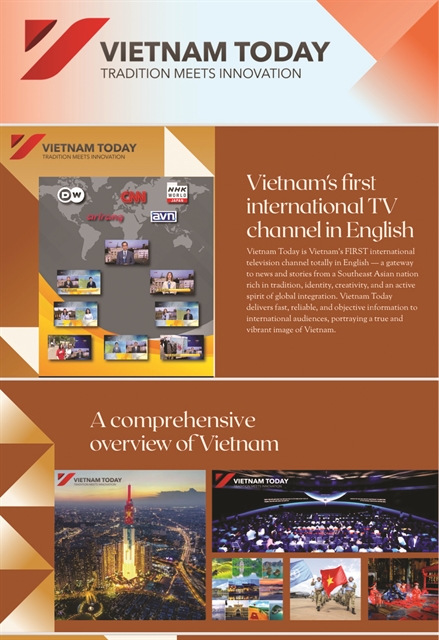 |
| VTV4's new channel -- Việt Nam's first international TV channel in English. |
VTV4 would learn from successful models such as NHK World, CGTN and BBC World News, and must establish a distinctive identity in its approach, storytelling and engagement with global audiences, she added. VNS



